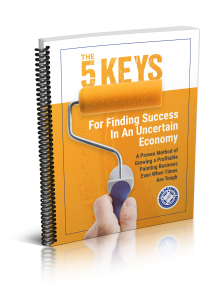How Much Money Are You Really Making In Your Painting Business?
While you may have not started your painting company exclusively to make money, it is likely one of the biggest reasons you decided to go out on your own. While it’s easy to get caught up in simply “getting the job done,” it can often distract you from the primary objective of increasing your personal income.
With all that having been said, today I would like to teach you a three step method for projecting your income and better managing your painting business by really understanding how you make money in painting. Now, this will be a little bit simplified and maybe even chaotic. I have in our program a cash flow projection module that does this in more detail. I’m not going to get into every single little detail, but I’m going to outline the major things here for you.
I thought this would be more entertaining than a spreadsheet. Now, the big reason that I’m doing this is because about 15 minutes into business diagnostics, which is what I do before someone joins the APPC, I spend time talking about macro metrics, and macro metrics are big numbers that indicate the health of a painting business.
One of those is what I refer to as cash flow to owner, basically how much money you make when you combine your profits, your salary, if you’ve bought vehicles, health insurance, gym memberships, you name it and you’re paying for it through the company and it’s a benefit to you. I like to see people at about 30% cash flow to owner. If you’re running a $500,000 painting business, I want you to be making $150,000 if you do not work in the field at all.
And also if you are running a million dollar painting business, you would make 300,000. Now, if you work in the field, that time is going to be built at an hourly charge rate. And of course, that will come to you as well and it will flow into your income. We’re going to talk about this stuff. I’m going to be leaving some things out, okay? I’m not going to try to get every everything in here. It would be too difficult, but it’s important to know how to do this.
And another reason that I’m doing this is because when I get on the phone with people, they don’t know. They can’t tell me. I’ve done 2,400-ish hour long interviews, diagnostic surveys of all kinds of business systems in a painting business, and I’m just amazed at how often people just don’t know. The only time they do know is kind of like when it becomes tax time, but that’s not helpful. You need to know what your income is every month, every week. You need to understand how it happens.
The first thing we’re going to do, I’m going to get my handy dandy calculator here, we’re going to talk about the main place, not the only place, but the main place where revenue is generated in a painting business. And that is the number of painters that you have in the field and the number of hours they work. We’re going to do this on kind of a weekly basis to start with, and I’m going to change these numbers to monthly as we go. Okay?
First things first, and if I screw up, apologize in advance because I’m doing this on the fly. Let’s say that you run… Let’s keep it simple. Let’s say that you run a painting business and you’ve got five painters out in the field. Just five. Okay? You got five painters out in the field and let’s say that maybe you pay them… You got five painters. One gets 21, one gets 18, one gets 23, one gets 12, one gets 11, whatever the number is.
And let’s say when you average all that out, your average pay rate, this is what you pay the painters. Let’s say it ends up being $20 an hour. It may be more, but for simple math let’s do 20. That means it’s $100. Five times 20 is $100 per hour that you’re going to pay out in labor. Every hour that a painter is working, right? $5 times 20 is $100 an hour. And let’s say that you have… These are W-2 employees. They’re not subcontractors. I can do this for subcontractors, but I can’t commingle it here.
I can show you how to do this. It’s something I routinely do. But for now, let’s keep it simple with W-2s. There’s a little bit different thing that happens up here with subs. I don’t have time to get into it. But for right now, let’s just do W-2 employees. Let’s say that your labor burden is 20%. You take 100 and you multiply it times 1.2, and that’s going to equal $120 per hour. Now that’s what you pay. When you’re paying all your guys out in the field, you’re shelling out $120 an hour.
Every hour that’s what you’re shelling out. Now, you’ve got to have a charge rate. Your charge rate is what are you charging the client. What are you charging the client per hour? I like our guys to be at a hundred and… Or not a hundred. Our guys to be at 50% gross profits, which means that you essentially double what you charge the client. In this case, this is $120 an hour. And If we divide that by five, that’s going to equal… 120 divided by five, it’s $24 an hour.
Your average pay rate is $24 an hour. You got $120 an hour that’s going out. Now, if you double this to charge $48 an hour or let’s say $50 just to have a nice round number, then that means that if you’ve got five painters times $50 an hour, that means you’re charging $250 an hour. If we take away the $120 an hour, that means that you are making $130 per hour. $130 an hour. Now, this assumes, assumes that you are coming in exactly on budget.
That if you have five times 20, which is 130, and if everybody’s working 40 hours, that would mean you take 120… Let me clear this out here. You take 120 times 40, that’s $4,800. Let me make sure this is correct. 120 times 40, $4,800 an hour. You’re going to make $4,800… Not an hour. It means you make $4,800 a week, right? $4,800. Now, if, for example, you are 10% under budget, that number is going to change. Let’s pretend like you’re 5% under budget.
You can do that by instituting job costing, production rates, save labor bonus program. These are all things we teach people to do in our program. We’re just going to take 4,800 and we’re going to multiply it times 1.05, which is 5,040. I’m going to back out to 4,800. I should have done that a different way. So you got $240. Plus 240. Now this is your gross profits. I’m sorry, I kind of did this backwards. Phase one is gross profits. Phase two is non-field staff, and phase three is non-variable field overhead.
We’ll get through all these sections. Right now this is kind of the gross profits that have been produced. We’re going to say this 240 is under. I’m going to put under on top of this. That means we’re under budget. Now, you also have another profit center, or you should, and that’s your materials. Now, I know material prices have gone up and up and up and everybody’s worried about shortages right now.
We have a program called the Painters Purchasing Group, where we have negotiated lower paint prices, about 35% lower on average. That’s another video for another time, but you should be making money off of your materials. And let’s say you’ve got this charge rate that you have over here, where you’ve got 250 an hour that you’re charging. And let’s say 250 times 40, well, that’s $10,000, right? That’s $10,000 that you are billing out per week in labor. Let’s say that your materials are 15% of that.
Just the cost times or it could be the whole thing. Times 0.15 equals $1,500. Now, you should be at least doubling your money on your materials, but let’s say that you’re only marking them up about 35%, times 0.35, then that should be an extra profit margin for you every week. We’re going to add an extra $525 here. Let’s say that you’re under budget on your materials times 10%, and let’s just multiply that times .1, that means that we’re just going to round it up to $52. This is 52.
We’re going to put this under mark again here. 4,800 plus 240 plus 525 for materials plus 52, that’s where all your gross profits come from. That’s the only place gross profits come from really is where you generate this money with labor and materials. This is how you make money. If you want to know how to make more money, you add more painters and there’s a few other things we can talk about here, but this is how it’s basically done. There’s some things I’ve left out here.
All this is variable. I can also put with gross profits, it’s variable. Variable. Let’s add this up real quick. I’m going to clear this out. 4,800 plus 240 plus 525. Is that right? 525 plus 52. You should have $5,617. I’m going to put this over here in the corner, 5,617. Everything that you’ve got to make now comes out of this 5,617 a week. This is weekly for right now. Now, out of that 5,617 has to come what I call your non-field staff.
As your company gets bigger, this number is bigger. It starts out small. Let’s say you got a part-time admin. And at five painters, you’re probably not going to have… Five painters, you really don’t need much more than a part-time admin. I could add some estimators, operations managers here if this was about 10 people. Maybe I should have started with 10 up here. But let’s just keep it simple.
You got a part-time admin, and they’re coming in 16 hours a week, two days a week, just to help you out with marketing and standard stuff you could give up and give to people. Let’s say you pay them 20 bucks an hour. I don’t know what you’d pay them. It depends on your area. 20 times 16 is 320. And let’s say another common thing that you might have is a bookkeeper. Let’s say it’s just like four hours a week and you pay them $35 an hour. Let’s go four times 35 equals 140.
If you add those two things up, you got 460 that comes out here, so that’s a negative 460. Now, your non-variable overhead… Now, before we move on, the thing that’s beautiful about this up here is that if you change this number here, this $50 an hour number, or if you change this number, how many painters you have in the field, it’s going to make a huge difference on this number over here. If you go over budget versus under budget, that’s going to make a big difference in this number over here.
Are you following me so far? I mean, all these little changes up here… And one thing I failed to mention, I’m always worried about over complicating these videos, is all this has to do with what are the quality of your leads coming in. Are they all repeat and referral and commercial repaints? Are they all referral sources from B2B referral sources? Do you get them from the operational marketing you do as you paint houses, or are you strictly getting cold crappy internet leads exclusively?
Now, you have to have some of those in the mix. But depending on the percentage of those that you have, it’s going to have a huge impact on if you can command this $50 an hour. In many cases, this is kind of low. It’s probably about 55, 65. For some of you, 75, even $80 an hour. I’m keeping these numbers low for the sake of simplicity. These are going to change by the market. This is all here. Don’t get it caught up in the numbers, what the dollar amounts. These can change according to your market.
It also has a big deal to do with your sales system. If you got a crappy, non-persuasive sales system, it’s going to be very difficult to command that premium price, but let’s just keep it here for now. And your cost of living will make these things change. These are your non-field staff. You only got two people helping you out part-time. If this were a larger company, you’d have maybe an estimator or an operations manager in here, maybe more people, maybe two salespeople, depending on the size of the company.
I’ve worked very big ones, $3 million, $20 million, $50 million. This all looks different in those cases. So then you get down to non-variable overhead. Now, the 120 up here, this we talked about, that’s insurance and maybe FACA and other taxes, so insurance, tax, and it’s all variable. It’s just driven by the job. Then you got non-variable overhead. Let’s just put some stuff in here. Let’s go gas. This is a week. I’m going to say with Joe Biden in office, this is at least probably $200.
And you’ve got let’s say utilities. If you rent some kind of little office, maybe it’s just a surcharge. We’re putting stuff in here for the sake of the exercise. 100. Let’s say that you’ve got… What are some other basic overhead? Say marketing, just little dinky stuff you do on your own, $100. What else would be some basic overhead? Maybe tools. I know I’m putting a lot of… It’s probably not a hundred, 50. What’s something else that’s basic overhead? I’m drawing a blank here.
Tools, painting, gas. I’m just going to put meals for crew. Just nice things to do for them. We’ll put that in here as a hundred. There may be other things. Okay? I’m just trying to keep this simple. If we add this up, that’s 200, 300, 400, 450, 550. That means that we got negative 550 down here. And usually if you have a small crew, you only got five painters and you’re not in the field in this case up here, then this is going to be a low number.
I’m actually at the end I’ll show what it would be like if you’re working 30 hours in the field and use 10, maybe 20 hours outside of that to do prospecting, business improvement, courses, running estimates, doing basic office work. So now we got this. We got to take 5,617, we take 460, we take 550 away from it. We take 460. Whoops! Take 5,617 minus 460 minus 550. I messed that up. Sorry, guys. 5,617 minus 460 minus 550 equals 4,607. That’s how much you should be making weekly in this case.
We’re going to multiply that for a monthly calculation by 4.2, which is about how many weeks are in a month on average. 4.2 times 46… Oh, hold on a second. 4,607 times 4.2 equals that’s 19,349. We’re going to round it up to 19,350. that’s pretty good money. Times 4.2 is 19,350. And that’s truly how much money you can make if you hit these numbers with just five painters. As you add overhead, that would come out of there. If you have more field staff, that would come out over here.
Now, if you don’t manage your field budget, and if you don’t hit your numbers, if you’re not under, this number is not going to be as big. I mean, you can look here that being under on materials is about $300 a week. 300 times 4.2 is going to be roughly, what is that, 400… Say 350 times four will be 1,200… About $1,500 dollars lower if you missed your budget, if you were down, back to basics. And if you were 10% under, that’d be about $3,000 that would come out of that 19,000, which would be…
You’d be down to 16. All these little numbers make a big difference. And let’s say that you work 30 hours a week and you’re charging that $50 an hour and you’re getting directly for your labor. Well, then that would be three… I think that’s 1,500, right? Yes, 1,500. 50 times 30, 1,500 times 4.2, that’d be 6,300. We’re going to subtract this 20% up here. I think you’d have to pay that. 6,300 times, I think this works, 0.8 is 5,040. That number may be a little bit at less.
I’m going to put less tax insurance, which means you’d really have a take on pay of 5,040. And if you add this 19,350, you can truly make about $24,000 a month running five painters, hitting your numbers. Now, I see people do this. I can give you numbers for people that do this. And I also see people that are running five people crews that make $80,000 a year instead of… Now, you probably would make $24,000 every month. For example, let’s say that you did that times nine, that would be 219,510.
And let’s say those are your peak months. Let’s just round that up to 220 for simple math, 220K, and let’s say that there are… You multiply that times 0.6 and let’s divide that by nine. Maybe you only make 14,000 the three other months that it’s slow in the winter. We multiply that times three. I may have lost some of you. That’d be 43,902 plus the 220,000, so that would mean that you’d make $263,902 for that year if you did the same thing, right? If you did the same thing over and over again every month.
This is how I help people figure out how much money they make and what their decisions and their business systems end up doing to their personal income down here at the bottom. We have a cashflow projection sheet. It’s a little bit more complicated than this. Not complicated, but it takes them to account a lot of smaller things that you really can’t do on a whiteboard here. But this is the essence of it. To sum up, all your money is made up the top here. All your money is made up the top.
All the money is made by hitting your budgets and being able to command a high price with sales systems and good lead generation and hitting budgets and save labor bonus programs, by marking up labor and material. You buy labor and material wholesale and you sell it retail. That’s what you do in a painting business. Hitting budgets. Down here we take out our staff that help us run our business. And down here we take out our non-variable overhead.
These are things that are kind of fixed no matter how much work we do. And then we’re left by the time we multiply it all out with our take home pay. Of course, Uncle Sam or Uncle Joe or whoever it is takes out 30% of that, and then your state government takes out another 10 to 15 to 20% of that. You’re left with about half of it. It looks real big, right? Oh, you mean I can make 263? Well, yeah, but you’re probably only going to be able to keep about… Probably able to keep about half of it.
That’s why it’s so important to get this so that your take home pay is good for you and your family. If this is confusing and you need a simplified way to do it and if you’d like to talk because you don’t really understand how money is made in a painting business or maybe you do conceptually after seeing this and doing some simple back of the envelope math yourself, like I just did here in front of you, but maybe you’re saying, “I don’t want to have to learn all that stuff from scratch.
Brandon, I don’t have time for that. I don’t want to reinvent the wheel. Somebody’s taught me how to paint. Why don’t I get somebody to teach me how to run my painting business?” I’ve helped about 450 painting contractors in six different countries do this stuff. And if you’d like to set up a call to speak with me, just email me, brandon@paintersacademy.com. I just plainly talk through this stuff. I’m not salesy. It’s just like, here’s what you need to fix. If you want to fix it, great.
If you don’t want to fix it, keep making what you’re making. It makes no difference to me. Brandon Lewis here with Painters Academy. I hope this is helpful. And again, I did it because people just really don’t understand where the money comes from in a painting business and people can’t tell me how much they’ve made or how much they will make when I talk to them and it’s a problem. I got a lot of feedback from that email I sent previously. I meant to do a video instead of an email, but I ran out of time.
This is going to have to do today. All right, guys. Take the care. Email me. Be happy to set up a diagnostic call. If I can ever help you or anybody you know, let me know.
Take care.
The 5 Keys for Success in ANY Economy

Discover the key to unlocking the hidden income potential in your painting business.
Hear What Other Members are Saying:

Jim and Lorraine
“Our first campaign reached $60,041.98! That's a huge percentage of our annual sales! You don't pick the peach orchard just one time. Different peaches ripen every day. Thanks for encouraging us to keep after it!”

Eric
“15 requests for quotes and closed and/or completed $23,000 of work and I still have a few more to do. Conservatively this campaign will net $25,000 in found money in the first 45 days! Thanks Brandon!”

Torlando
“This year has been the biggest year of growth for us. We're double where we were last year. I realized the real money in this business is in the marketing of the services - not the doing of the services.”
The 5 Keys for Success in ANY Economy
Discover the key to unlocking the hidden income potential in your painting business.

